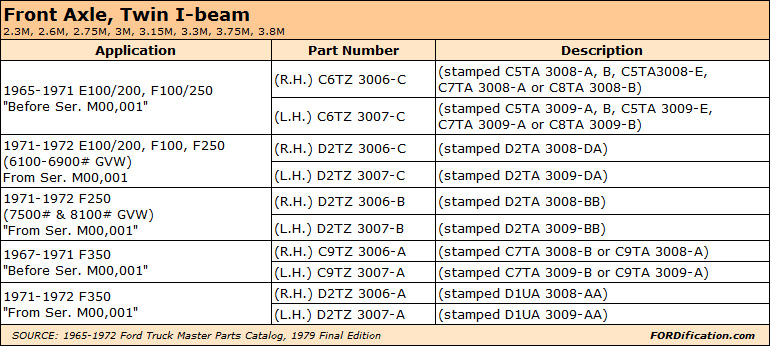|


|

|
|
|
Steering/Suspension Component Variations |
|
 |
|
IMPORTANT NOTE:
Ford did some redesign of the front end components beginning on
late-'71 trucks, including the Pitman arm. If you're installing a
disc brake setup on an early-'71 truck or earlier and attempt to use
your original steering linkage, you'll might discover that the drag
link will not fit the Pitman arm, meaning you'll have to use the
steering box (or at least the Pitman arm) from the donor truck. Read
the scans at right from the factory Technical Service Bulletins for
more info, and scroll down for some side-by-side comparison shots of
the variances mentioned in the TSBs. |
 |
 |
|
Removing the Pitman arm
If you have access to a heavy-duty puller, removing the Pitman
arm from the steering box is easy. Just put a little pressure on
the puller and tap the arm with a hammer, repeating the cycle as
needed until the arm pops off. In the absence of a puller,
you'll need a hydraulic press. |
 |
|
Inspecting the Pitman arm
Before removing the Pitman arm, grab it and give it a few good
tugs and twists, to ensure the splines are not worn and that the
Pitman arm is installed tightly. At right is a close-up of one
that was loose...if you look closely you can see the worn-out
splines on the near side. It was very worn (loose on the shaft)
and is no good. |
 |
|
Steering Linkage Differences |
|
FYI: |
For the purpose of this tutorial, the following
terms are used:
EARLY: trucks with serial numbers prior to
M00000
LATE: trucks with serial numbers M00000 (late
'71) and higher |
|
 |
STEERING LINKAGE ASSEMBLY:
The early and late styles are each shaped very differently,
though they are interchangeable as an assembly, provided all
matching pieces are used...including the Pitman arm on the
steering box. |
|
 |
DRAG LINKS:
The early and late drag links are identical in overall length,
though the early style is much straighter. In the pictures at
left you can see the slightly different angle of the left-side
of the drag links. You can also see that the position of the
tapered hole for the tie rod end was moved farther outboard for
the later style drag link, though the tie rod end is the same
length. |

Top:
late style
Bottom: early style |
 |
TIE ROD ENDS:
The later tie rods ends are much straighter than the early
style. |
 |
Here's a view of the differences
between the stock '67-'72 vs. '73-'79 tie rod ends, where they
connect to the spindle's steering arm. This is due to the later
spindle's steering arm being thicker. Therefore, early steering
linkage cannot be used with later disc-brake spindles without
some grinding on the spindle's steering arm to allow the tie rod
end to protrude through enough to install the castle nut and
cotter pin. |
 |
The '73-up spindle's
steering arm is thicker than the '67-'72 versions. Here's a view of the
later spindle, this one from a '79 F150. |

|
 |

Want to link to
this site? Please save this banner to your hard drive to place on your
webpage.
The correct link to use is
http://www.fordification.com
|